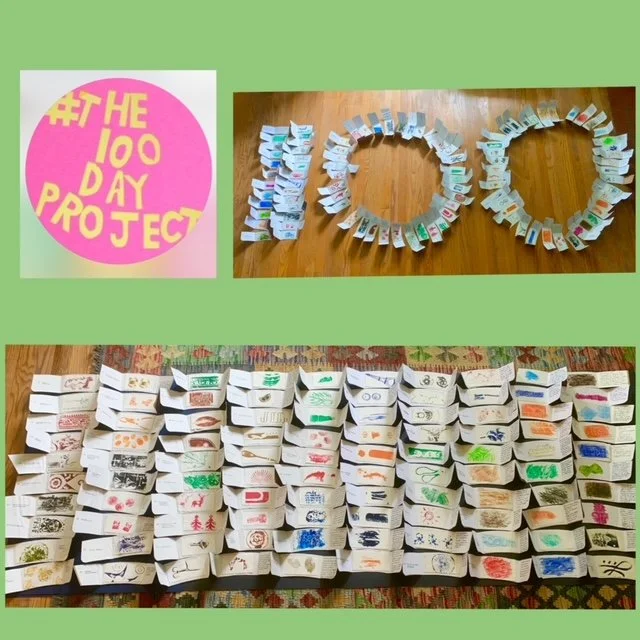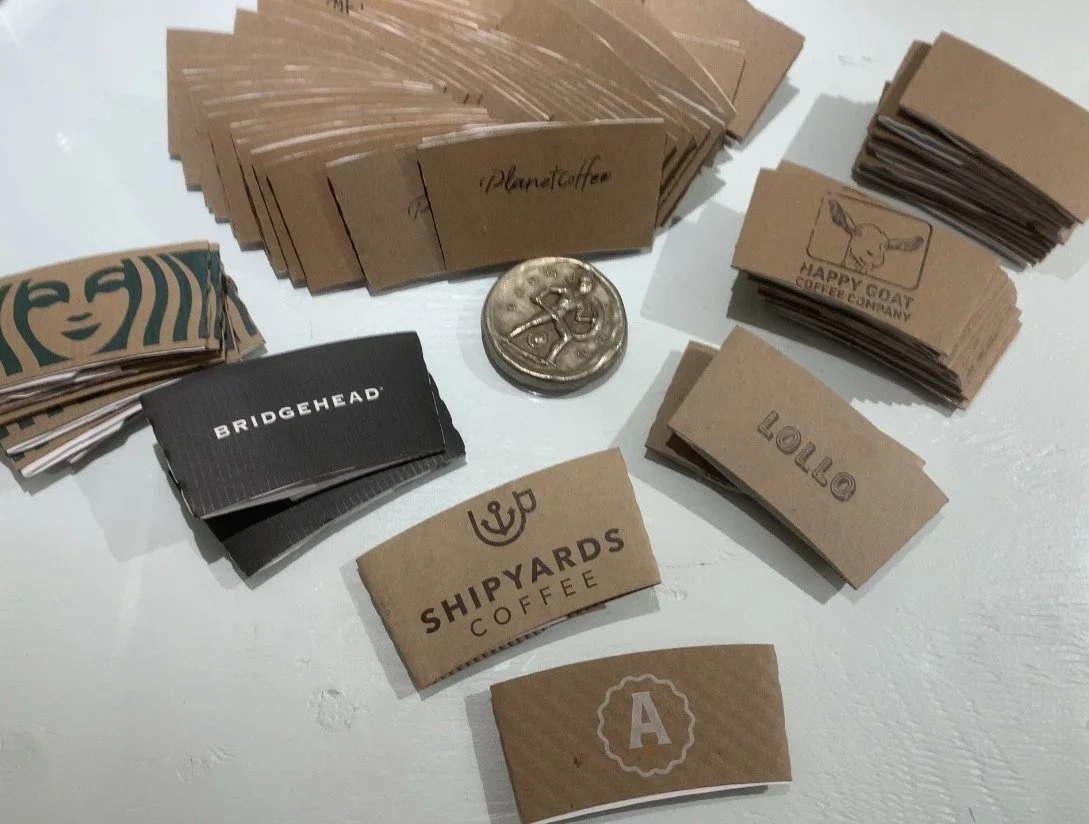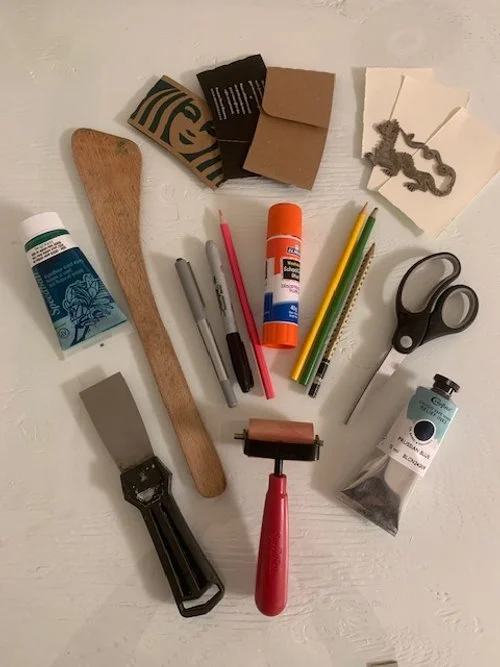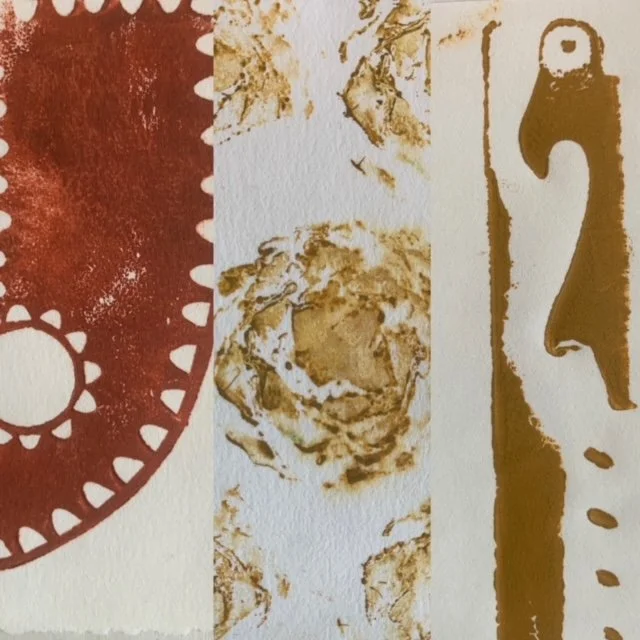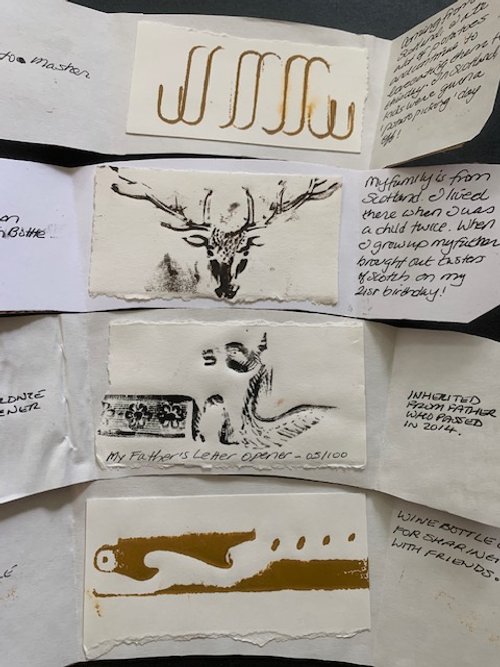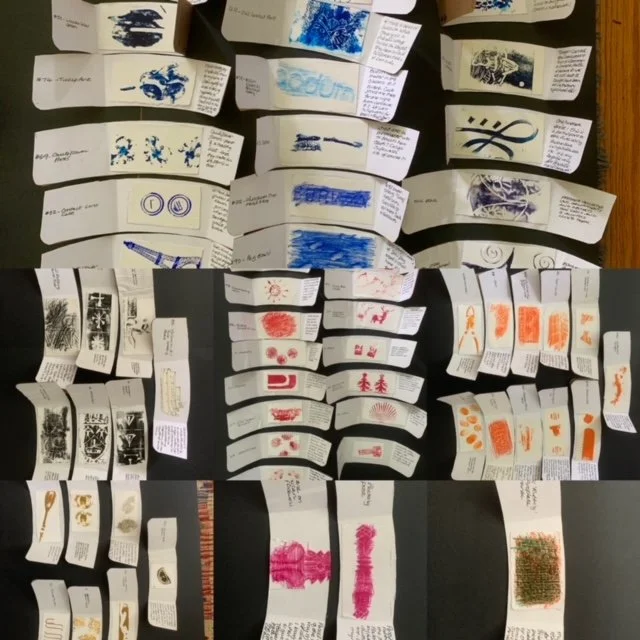‘Tokens of My Life’ - 100 day project
‘Tokens of My Life’: One hundred mini prints and stories in coffee sleeves!
Lattes. Art. Travel. Outdoor Adventures. These are my passions. Playing cello led to my coffee addiction; or, more specifically, a raven-haired Irish ‘cello teacher who held teenaged me in awe with her stories of her extraordinary, passion-filled life. Art, travel, and a love of the outdoors stems from growing up between Scotland and Canada, in part, with a Glaswegian printmaker. Over the years, my caffeine addiction has only gotten stronger. I blame my café sketching habit and studies in Italy. However, the fact I have a daughter earning her way through art school as a barista is also not helping!
Coffee Sleeves for Coffee Sleeve Art!
‘Tokens of My Life’ is my contribution to the 2024 @dothe100dayproject. My understanding is that this free, global, on-line initiative is designed to build creativity and by asking people to design and post a daily project of their choosing for one hundred days. In my case, I was fueled by a desire to make art using my vast collection of cardboard coffee sleeves and a wish to do something purely fun in printmaking.
Coffee Sleeves serve as wonderful ‘Books’ and are Compact!
My goal for the @dothe100dayproject became to create one hundred miniature prints of ‘tokens of my life’ keeping the following ideas and objectives in mind:
To find fun, interesting, and meaningful items in my home with which to make prints.
To use my existing supply of Caligo safe wash relief inks or Speedball relief inks, rollers, and other printmaking equipment I already had in my home.
To handprint each miniature print on existing scraps of Stonehenge or BFK Rives printmaking paper found in my home using a wooden spoon.
To paste each print within one of the coffee sleeves and write a short note sharing a story about each one.
To ensure a consistent look and feel with each coffee sleeve token ‘story’ including the series title, my signature, and the number of the print in the series.
To post each ‘story’ on social media daily or as frequently as possible.
My Project Tools and the first object printed: an etched dragon!
My process included each day, or every few days, finding objects to print in my home. I began with a tiny cut-out dragon etching my father had made years previously and ended with a print of the logo I hand carved for my own art practice. I rolled out relief ink in a random colour using my speedball rollers, inked the object, and then hand printed it using a wooden spoon or spatula depending upon the object’s shape. Once the print was dry, I would paste it into the interior of a coffee sleeve which had been covered with white paper. Then, I would write the token’s number, title, and a short description of the object or its meaning in my life. As the objects ranged from half a Brussel sprout to the logo on a single malt bottle, this became quite fun.
Abstract Art? Prints made with an Owl sculpture, Brussel sprouts and Bottle Opener!
As with many creative projects, this one did evolve over time. My brief descriptions became more detailed stories, and my objects began to include leaves, or other items I found on my walks in the local woods not just in my home.
When, I travelled to Vancouver and Gibson’s, British Columbia, during the 100-day project, I decided to continue my daily project but using different materials (as I didn’t think my inks and rollers would make it through airport security!). I packed a small pile of scrap printmaking paper and a selection of Faber-Castell pencil crayons. In both locations, I found objects, from driftwood to bike stands, to take daily rubbings of, including a series of metal covers with text along Granville Street. That was a lot of fun! Once, home, I alternated between prints and rubbings; finding the latter useful for objects I preferred not to leave inked.
Prints ranged from Scotch Bottle Stag to Potato Masher!
The result of this project is that I know have essentially one hundred prints and wee stories which together provide a fun, engaging way, to share a little window into my life and taught me a great deal. You can find out, for example, that I love mashed potatoes (having lived in a country where potato picking in the fall warranted a week off school!) and that gold safe wash ink mixed with a potato masher makes for great abstract art!
Now, I am sure you are intrigued to find out more about this project’s learnings! They include:
The majority of my cardboard coffee sleeves are from the ByWard Market’s Planet Coffee (64 of 100)! This is not surprising as I began going to Planet Coffee when it first opened, and I had just moved to Ottawa in1994. Since then, I have both worked close by and studied fine arts at the neighbouring Ottawa School of Art (2022 Graduate). Others include Happy Goat (11), Lollo (2), Bridgehead (2), Starbucks (7), Shipyards (1), and Analog (1). The latter two coffee shops are Vancouver-based with Analog being my daughter’s previous workplace! The remainder have no logo, so their sources are unknown.
In terms of colours, blue dominates (i.e., Prussian, process, light, dark) and is found in 23 prints. It is my favourite colour with my front door, car, outdoor furniture, and many of my clothes all in variations of this colour. My cat? White, except when I was printmaking in blue! The other colours include 18 browns (i.e., burnt sienna, sepia, light and dark), 16 greens (i.e. process, light, dark, turquoise), 15 reds (i.e. process, magenta, light, carmine, light, dark). Golds (i.e. yellow ochre and gold), 7 black, 2 pink, and one rainbow (i.e., mix of green, orange, and black).
Out of 100 coffee sleeves, only 13 include the orders of the customers by the baristas. I know many people generously gave me their coffee sleeves as I don’t recognize most of the orders for Oat, Chair, or Cappuccinos. I am a soy latte gal. End of story!
The most successful prints made with ink tended to be, not surprisingly, of objects with high relief or well-defined patterns. That is, the beautiful stag ornament on the single malt or the detailed Eiffel Tower bottle opener. Broccoli, wet or dry, printed just looks like collections of dots.
Pencil crayon rubbings were a bit nebulous at times. Driftwood or shells did not translate well. But capturing raised text on metal objects was very successful. And, they did have the advantage of being quick!
Colour Distribution: Blues Dominate! Pink and Mixed Color Palettes were minimal!
This challenge was a positive experience for many reasons:
It did get me into the studio daily and got me trying out different inks, rollers, paper, and textures.
It made me observe objects in my home more closely. I began looking at everything in terms of its printmaking potential. I started gathering objects I had not thought about as anything but utilitarian. There is a lot of potential in your kitchen drawers!
It allowed me to reuse or recycle existing materials in my home rather than throwing them out (i.e., coffee sleeves, scrap printmaking and sketch paper).
On my travels, I found myself more present and engaged. While walking down to the ferry in North Vancouver, I found myself walking across a bridge in an industrial area. One of my favourite pencil crayon rubbings is taken of text found embedded in the bridge’s metal strut which I might have just passed by previously.
It gave me permission to experiment and explore, for example, printing with Indonesian fabric blocks my stepmother had given me or using natural materials such as leaves and shells.
It brought up and captured family stories which I could share with my girls, such as why I have the logo for one of Canada’s former arts organizations (my mother, a printmaker, was an administrator there).
#1 Dragon etching to #100 Artist Logo with Full 100 Prints and ‘Blues’ in between!
My recommendations for embarking on an art challenge?
Gather and prepare the materials you will need ahead of time.
Know how much time you can realistically dedicate to the project and plan accordingly. My project took far longer than expected. I had to find and print objects, paste them into a coffee sleeve I had inserted with plain sketch paper, write a story, title each one, and then post photos of them. However, it was a great deal of fun and I am very happy with the resulting collection.
Keep it simple even if it you are using this challenge to serve as a basis for future creative projects (e.g., miniature paintings to be expanded upon in the future). Decide on one medium, technique or process.
Commit to a daily practice but give yourself permission to modify that timeline when necessary (i.e. doing a batch every few days).
Do experiment.
Do modify or evolve the project over time especially if techniques, materials are not working for you, it is taking too much time, or is not engaging.
Do record your daily practice with photographs even if you are not posting on social media. It can be a wonderful way to inspire new artwork and to just feel a sense of wonder and accomplishment.
Keep it fun!
One hundred Coffee Sleeves. One hundred Prints and Stories!
If you wish to see highlights of my @dothe100day project ‘Tokens of My Life’ as it was evolving, please visit https://www.instagram.com/siobhan_new_adventures/?hl=en.

